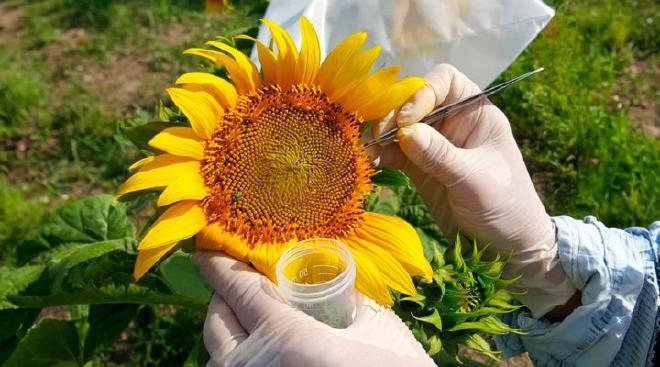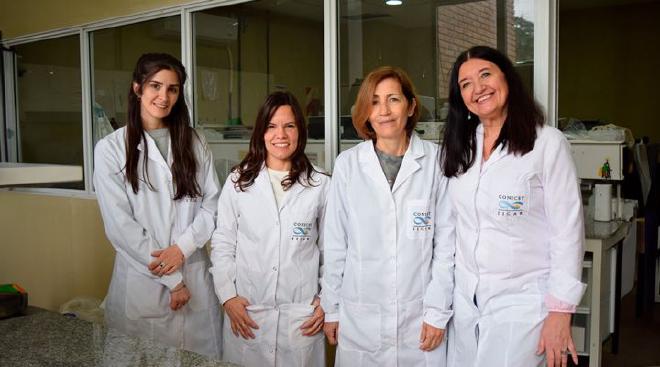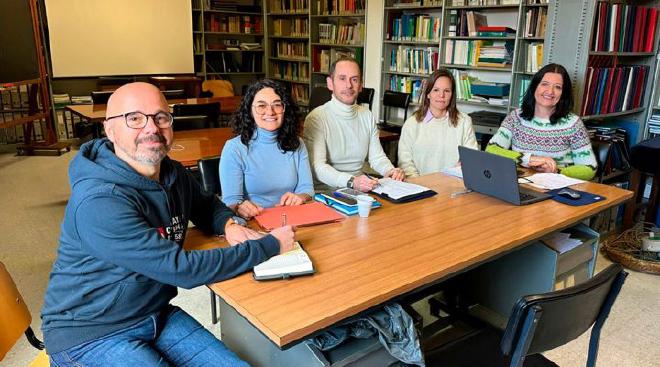

A team from CONICET at the Institute of Agricultural Sciences Research in Rosario (IICAR, CONICET-UNR), in collaboration with colleagues from the Faculty of Agricultural Sciences at the National University of Rosario and researchers from the University of Perugia (Italy), recently presented a discovery that could lay the groundwork for accelerating, simplifying, and economizing the genetic improvement processes of sunflower seeds, a crop of great agronomic interest. It is about verifying that some sunflower lines complete the first stage of apomixis (asexual reproduction via seeds). The promising finding was published in the scientific journal Scientific Reports.

Apomixis is a natural process that allows plants to produce genetically identical seeds to the mother plant (clones) without the need for fertilization. “Not all plant species have this capability, but not many have been revealed either; and that is the central issue, few have been studied,” explains Silvina Pessino, a researcher at CONICET in the Plant Reproductive Development group (DREP) of IICAR and the first author of the article. “That a crop of great agricultural importance like sunflower could reproduce in this way would imply the possibility of generating more easily and economically seeds with high adaptability, superior quality, and greater yield. “Although there are species that reproduce asexually from vegetative propagules, a part of a leaf, root, or stem, in apomixis, it is the very formation of the seeds that occurs asexually,” she pointed out.
In agronomy, it is common to cross two different varieties of the same crop with the aim of obtaining seeds with desirable agronomic characteristics such as, for example, higher yield or disease resistance. The limitation of this genetic improvement strategy is that when first-generation hybrid plants reproduce sexually, their genes segregate and recombine, with the possibility that the desired traits may not be present in their offspring. In this sense, the possibility of cloning through apomixis could save the difficulties that the generation and recreation of hybrids entails.
The expansion of sunflower into regions with poor soil quality and greater agroecological stress has led to reductions in yield; this poses a challenge for plant breeders (professionals dedicated to the genetic improvement of plants). The work published by the researchers at IICAR addresses an urgent need to develop stabilized cultivars (genetically improved crop varieties) that not only exhibit high adaptability and quality but also offer a more efficient and profitable production than current varieties.
The Finding #
When Ana Ochogavía, one of the directors, along with Graciela Nestares, of the Applied Biotechnology for Crop Reproduction and Improvement group (BioAp) at IICAR, was studying the reproduction of sunflowers for other reasons, she noticed (thanks to having completed her doctoral training on the topic of apomixis and polyploidy) that some of the lines of the crop she was working with exhibited the typical characteristics of apomixis. That was the starting point of the research.
“In a previous study, we published that in cultivated sunflower there were signs of one of the stages of apomixis, because we observed structures similar to aposporous apomictic embryonic sacs (formations typical of certain apomictic plants) during reproductive development,” recalls Ochogavía. And she continues: “We published that in 2022 in the journal Crop Science. In this second research, we demonstrated that the structures we had seen in the developing ovule, within the ovary of the sunflower, are indeed the ones that characterize the first stage of aposporic apomixis (Apospory).” This happened because they observed that by fertilizing the apomictic embryonic sacs with male gametes, hybrids with three sets of chromosomes (triploids) were formed, two coming from the mother plant (present in the sacs) and one inherited from the father. That is to say, they confirmed that the reproductive structures they initially observed were viable and that they can be fertilized to form polyploid individuals (with more than two sets of chromosomes). “The appearance of polyploidy in the progeny confirms that this plant completes the first part of apomixis,” highlights the scientist.
The joint journey of the researchers #
Ochogavía’s academic trajectory focused on the study of herbicide resistance and the reproductive characteristics of sunflower. Her group has developed bioassays, services, and technology transfer projects. Her doctoral training included topics related to reproduction and polyploidy of grasses, with Pessino as the director of her undergraduate thesis in biotechnology and later of her doctoral thesis.

“The interesting thing -says Ochogavía- is that now we find in the sunflower a phenomenon related to the topic of my initial thesis and doctoral training (apospory apomixis). That’s why we are working again with Silvina (Pessino) in this line.” Pessino adds: “What Ana (Ochogavía) discovered about four years ago is that in two lines of sunflower used as fertility restorers in breeding schemes, characteristic embryonic sacs of apomixis form in the ovaries. Initially, she made that observation and published it.” What stands out in this second work is that they have been able to prove that these bags are indeed of the aposporic type. “And we were able to do it because when fertilization occurs, the ploidy increases, that is, the number of chromosome sets in the offspring,” the scientist states. “The work we have just published demonstrates that there is indeed apospory in sunflower. However, what we did not find in this work is that apomixis completes its second stage, because we did not see evidence of parthenogenesis”, she adds. That is to say, they have not yet observed that an embryo can develop from aposporic sacs without the need for fertilization.
How is the work going on? #
“In the studies we are currently conducting, we are working with polyploids (particularly tetraploids) derived from these same sunflower lines. As in most species, the complete manifestation of apomixis is associated with polyploidy, we have increased the ploidy level of the sunflower. We already have individuals that have four sets of chromosomes instead of two. We are studying reproduction in those lines,” mentions Ochogavía, highlighting that the experiments are also being conducted in collaboration with Italian researchers from the University of Perugia.
Citation #
Pessino, S., Nestares, G., Bianchi, M.B. et al. Diploid aposporous sunflower forms triploid BIII progeny displaying increased apospory levels and non-random genetic mutations. Sci Rep 15, 4808 (2025). https://doi.org/10.1038/s41598-025-89105-x. Authors: Silvina Pessino, Graciela Nestares, Marta B. Bianchi, Iara Katzaroff, Lucía Amato, Marika Bocchini, Gianpiero Marconi, Emidio Albertini & Ana C. Ochogavía
- The article Girasol: revelan mecanismo que podría abrir camino hacia nuevas estrategias de mejoramiento genético, signed by Andrea Guereta, Press Office of CONICET Rosario, was published in CONICET’s news section
About the research: #
Silvina Pessino, DREP group, IICAR-CONICET-UNR, Faculty of Agricultural Sciences, National University of Rosario
Graciela Nestares, BIOAP group, IICAR-CONICET-UNR, Faculty of Agricultural Sciences, National University of Rosario
Marta B. Bianchi, CIUNR, Faculty of Agricultural Sciences, National University of Rosario
Iara Katzaroff, Faculty of Agricultural Sciences, National University of Rosario
Lucía Amato, BIOAP group, IICAR-CONICET-UNR, Faculty of Agricultural Sciences, National University of Rosario
Marika Bocchini, University of Perugia
Gianpiero Marconi, University of Perugia
Emidio Albertini, University of Perugia
Ana Ochogavía, BIOAP group, IICAR-CONICET-UNR, Faculty of Agricultural Sciences, National University of Rosario

